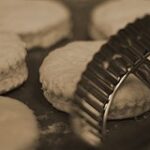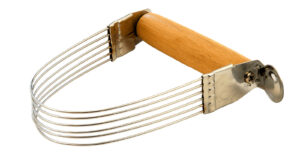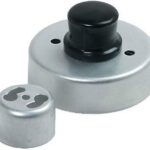By Catherine Haug, July 2021 (image, right, from Wikimedia Commons)
I found a couple interesting recipes for biscuits made with buttermilk in our local Daily Inter Lake newspaper (originally from the St. Louis Post Dispatch (1)). Two of those recipes (Angel Biscuits and Buttermilk Biscuits) use buttermilk instead of the heavy cream used in the other two recipes). All four recipes use all-purpose (white) flour.
However, I prefer to use sprouted whole grain flour (that I purchase from Granite Mill Farms in Trout Creek, Montana (2)), because sprouting partially breaks down the gluten, making the flour safely edible by those with gluten sensitivity. And also because sprouted grain flour is more healthful in general than white or whole grain flour. (See Flours & Starches: Sprouted Grain & Sprouted Grain Flour (About) for more about this). Thus, I have altered these recipes to use sprouted grain flour and to minimize the amount of sugar. You can use sprouted wheat pastry flour or sprouted spelt flour (which is slightly sweeter than wheat).
- Includes: 1. Unsweetened Buttermilk Biscuits; 2. Sweet Buttermilk & Yeast Biscuits
- See also: 1. Breads, Muffins, Rolls, Biscuits & Scones Menu; 2. Spelt vs Wheat in Baked Goods and Pasta; 3. Flours & Starches: Sprouted Grain & Sprouted Grain Flour (About); 4. Spelt vs Wheat in Baked Goods
About Equipment
If you are not familiar with these items, I’ve included photos.
- To cut the butter/lard into the flour mix, I use my pastry blender/cutter (see photo, right (4)), or you could use 1 or 2 knives.
- To cut the biscuit dough, I use my Mom’s old 2½″ wide donut cutter, with the center “hole” cutter removed (see photo, below-right, in recipe section, of similar donut cutter by Norpro, from Amazon (3)).
Unsweetened Buttermilk Biscuits
This recipe is based on “Buttermilk Biscuits” recipe. (1) This is the version I prefer, as I am avoiding sugar; also, it’s simpler to make. I also prefer to use sprouted grain wheat pastry or spelt flour (for the health benefits of sprouting), but also provide differences if using all-purpose wheat flour. However, I’ve not yet tested this recipe.
For the fat: This recipe uses real butter, which is my preference. Other alternatives are:
- Homemade lard (I don’t recommend commercial lard, as it has been hydrogenated, a process that produces trans fats; see my article on Rendering Lard for more about this).
- Cold coconut oil (not melted), so it can be cut into the flour; if it starts to melt while cutting, place the mix in the fridge for a few minutes to re-chill. However, I’ve not tested the coconut oil option.
- I do not recommend vegetable shortening because, like commercial lard, it has been hydrogenated, a process that produces trans fats. NOTE: prior to the 1950s, “shortening” referred to any solid form of fat that is solid at room temperature; lard (such as from pork or beef fat), or butter. But once the process of hydrogenation became available, “shortening” has been used for solidified vegetable oils (corn, soy, canola, etc.) and margarine; i.e., “Vegetable Shortening.”
This recipe does not need to rest overnight in the fridge. Makes 12 biscuits.
Ingredients & Equipment
- 2 cups sprouted wheat pastry or sprouted spelt flour* (or all-purpose white flour)
- ½ tsp unrefined sea salt
- 4 tsp baking powder
- ½ tsp baking soda
- 6 Tbsp (¾ stick) real butter, chilled for cutting into the flour mix
- ¾ cup buttermilk (preferably fermented from raw or simply pasteurized milk)
-
Equipment: - Large mixing bowl
- knives or a pastry cutter (to cut in the butter with the flour)
- 2½ inch (or desired size) donut/cookie/pastry cutter or drinking glass (see image, right, of donut cutter (3)); or knife if cutting biscuits into squares/rectangles
- baking sheet
‘* NOTE: spelt needs less added moisture or more flour than wheat flour in recipes. That is, spelt is not as dry as wheat, so you will need to adjust the amount of spelt or moisture. If using 1 – 3 cups spelt (sprouted or not), start out with ¼ cup less spelt flour than recommended for wheat; OR ¼ cup less buttermilk; then add 1 Tbsp at a time, as needed for proper texture. I recommend using wheat (sprouted or not) for your first batch, to note the texture needed.
Method
- Preheat oven to 450°F. Do not grease your baking sheet, tho you can use parchment paper.
- Mix Dough: Sift together flour, salt, baking powder and baking soda in a large bowl.
- Cut in butter using a knife, a pastry cutter or your fingers, until the mixture resembles coarse cornmeal. Quickly but gently stir in the buttermilk, just until the dough holds together. Don’t overstir or the biscuits will be tough.
- Knead and form dough:
- Turn dough onto a lightly floured board and knead gently with floured hands.
- Press dough into a ball, cut it in half. Place one half on top of the other and press down.
- Repeat three or four times.
- Roll out dough to about ½-inch thickness.
- Cut rounds with a biscuit-cutter or upside-down glass, OR cut rectangles with a knife.
- Place biscuits on an ungreased baking sheet, leaving a little space between them.
- Bake for 15 to 18 minutes, until the biscuits are golden.
- Remove from oven and serve after they cool just a bit (they should still be warm).
Testing Unsweetened Buttermilk Recipe
Not Yet
Sweet Buttermilk & Yeast Biscuits
This recipe is based on “Angel Biscuits” recipe (1). I prefer to use sprouted grain wheat pastry or spelt flour, but also provide differences if using all-purpose flour. Also, this recipe needs to be refrigerated overnight.
Regarding the fat for this recipe: I highly recommend using your own homemade lard to avoid GMOs; see my articles:
Or you can use real butter (not margarine). Another alternative is cold coconut oil (not melted), so it can be cut into the flour; if it starts to melt while cutting, place the mix in the fridge for a few minutes to re-chill. However, I’ve not tested either of these options.
Makes about 24 biscuits; you can form and bake a desired portion (for example, 6 biscuits), then refrigerate or freeze the remainder to bake another time. I use my Mom’s old donut cutter (with the center “hole” removed). Photo, above-right, from Amazon (3).
Ingredients & Equipment
- 4½ to 5 cups sprouted wheat pastry or sprouted spelt flour* (or all-purpose white flour)
- 2¼ tsp (1 package) dry yeast
- 1 Tbsp baking powder
- 1 tsp baking soda
- 3 Tbsp Rapadura sugar
- 1 tsp unrefined sea salt
- ¾ cup lard (or butter?)
- 2 cups buttermilk (preferably fermented from raw or simply pasteurized milk); NOTE: if using spelt flour (sprouted or not), you will need less buttermilk (or more flour)
- Equipment:
- Large mixing bowl
- 2 knives or a pastry cutter (to cut in the butter with the flour)
- Wooden spoon
- 2½ inch (or desired size) donut/pastry/cookie cutter (Photo, above right, from Amazon (3)); or knife if cutting biscuits into squares/rectangles
- Waxed paper or parchment (as alternative to plastic wrap)
- Baking Sheet
‘* NOTE: spelt needs less added moisture or more flour than wheat flour in recipes. That is, spelt is not as dry as wheat, so you will need to adjust the amount of spelt or moisture. If using 3½ cups or more spelt (sprouted or not), start out with ¼ cup less spelt flour than recommended for wheat, then add more spelt, 1 Tbsp at a time until desired texture is reached. OR use ½ cup less buttermilk; then add more as needed, 1 Tbsp at a time, for proper texture. I recommend using sprouted wheat for your first batch, to note the texture needed.
Method
- Day 1:
- Mix dough: In a large mixing bowl, stir together dry ingredients (flour, yeast, baking powder, baking soda, sugar and salt). Measure, then drop chunks of lard/butter into the flour; work in the lard/butter with your hands, two knives cutting across each other or a pastry blender. The flour will resemble grains of rice or smaller.
- Stir the buttermilk into the flour; mix it thoroughly but do not knead. The dough will be wet and heavy, but it will become stiff and workable after chilling in the fridge.
- Refrigerate: Remove dough from bowl (temporarily), then grease the bowl. Return dough to greased bowl, cover with waxed paper or parchment. Place in fridge to refrigerate overnight. (Cat’s note: I don’t like to use plastics so don’t recommend covering with plastic wrap, as in original recipe.)
- Next day:
- Preheat oven to 400°F at least 20 minutes before baking. Grease a baking sheet or line with parchment paper.
- Form and Bake: You can form and bake all the dough, or just a portion of the dough and refrigerate/freeze the remainder for another time.
- Determine how many biscuits you want to bake, then pinch off just enough dough for that number; return remainder of dough to fridge, or wrap and freeze it.
- Using the palms of your hands, kneed dough for 3-4 minutes. Roll into a rectangle, fold into thirds and roll again. Fold and roll one more time. The dough should be about ½-inch thick. Return to fridge for a few minutes to re-chill.
- Remove folded dough from fridge. Cut with a cutter or an upside-down glass; place biscuits on prepared baking sheet. Caution: Do not allow dough to rise (they will bake up taller, but will taste doughy).
- Bake on oven’s middle shelf for 15 to 17 minutes, until the tops are nicely browned.
- Remove from oven and serve after they cool just a bit.
Testing Sweet Buttermilk Recipe
Not Yet
References
- St. Louis Dispatch, article & recipes by Daniel Neman, originally from CampusCircle.com (campuscircle.com/review.cfm?r=26108&h=Blissful-biscuits-great-recipes)
- Granite Mill Farms (granitemillfarms.com/)
- Amazon image of Norpro donut cutter, ASIN B000HJ76BU
- Wikimedia Commons: image of Pastry Cutter/Blender



